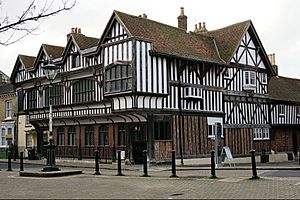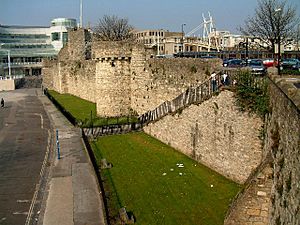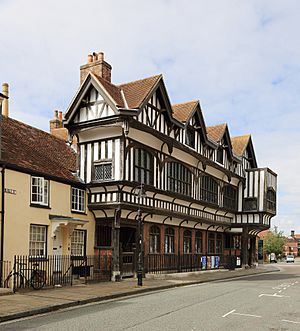Tudor House and Garden facts for kids
Quick facts for kids Tudor House and Garden |
|
|---|---|

Tudor House, as seen from St. Michael's Square on Bugle Street.
|
|
| Type | Tudor House |
| Location | Bugle St, Southampton |
| OS grid reference | SU 41869 11290 |
| Area | Hampshire |
| Built | 1491 |
| Architectural style(s) | Tudor |
| Owner | Southampton City Council |
|
Listed Building – Grade I
|
|
| Official name: Tudor House Museum | |
| Designated | 14 July 1953 |
| Reference no. | 1339964 |
| Lua error in Module:Location_map at line 420: attempt to index field 'wikibase' (a nil value). | |
Tudor House and Garden is a very old and important building in Southampton, England. Today, it's a popular museum where you can see what life was like hundreds of years ago. It first opened as a museum in 1912.
The house is located in Southampton's Old Town, on Bugle Street. It went through a major restoration and was closed for nine years before reopening to the public in 2011.
Contents
The Long History of Tudor House
The Earliest Building
The oldest part of the site is a Norman-style house built around 1180. Some people call it King John's Palace, but there's no proof that King John ever actually stayed there.
In the 1300s, a mayor of Southampton named John Whytegod lived in the house. In 1338, French soldiers raided the town. After the raid, the house's walls were made part of Southampton's new, stronger town defenses. Its windows were filled in and replaced with small openings for guns.
The Tudor Era
The main part of the house you see today was built by Sir John Dawtrey, who was a powerful and wealthy man. He was a Member of Parliament and a Sheriff. King Henry VIII gave him money to supply food for the navy and to help defend the town. He also helped build and supply ships, including the famous Mary Rose.
During the Tudor period, the house was home to other important people, like Sir Richard Lyster, who was a top judge in England.
A House for Merchants and Sailors
In the 1500s and 1600s, the house was used by merchants, including cloth makers. In 2007, workers found amazing graffiti on the walls from between 1570 and 1620. The drawings included ships, funny pictures of people, and exotic animals.
During this time, the house was owned by ship owners. It's believed that sailors and privateers (sailors who were allowed to attack enemy ships) stayed here and drew the pictures on the walls. This graffiti is now considered some of the best-preserved Tudor sea-themed art in England.
Changes in the 18th Century
In the 1700s, an artist named George Rogers owned the house. He made big changes, like adding a new wing in the popular Georgian style. He also covered the old wooden beams on the front of the house with plaster.
At this time, Southampton became a fashionable spa town because a special spring with iron-rich water was discovered nearby. This brought more wealthy visitors to the area.
A Time of Decline
During the 1800s, the house was divided up and rented out. It was used for many different businesses, including a dye works, a bookbinder, and a bonnet-maker's shop.
By the end of the century, the neighborhood around Tudor House had become a very poor slum. The area was scheduled to be torn down, and Tudor House was in danger of being destroyed.
Saving Tudor House
A New Life as a Museum
In 1886, a kind and generous man named William Spranger bought the house to save it from being demolished. He knew it was a special, historic place. He made some changes to the house himself and spent 12 years campaigning to turn it into a museum.
He succeeded, and Tudor House opened as a museum on July 31, 1912.
During World War II, the museum stayed open. When bombs fell on Southampton in 1940, the museum's curator and his family used the wine cellar as an air raid shelter. Tudor House was not damaged, but a house just two doors away was destroyed.
Repairs and Reopening
By the late 1990s, the old house was in bad shape. A 1999 report said the building's walls were leaning outwards. It needed major repairs to be saved.
The museum closed in 2002 for a huge restoration project that lasted nine years. Workers strengthened the walls, added new exhibits, and even built a new cafe. In 2012, to celebrate 100 years as a museum, it offered admission for just 6 pence—the same price as when it first opened!
The Tudor Garden
The garden was first created in the 1500s. The garden you see today is a recreation of a Tudor knot garden. A knot garden is a formal garden where plants are arranged in patterns that look like the threads of a knot.
It was designed by a garden expert, Dr. Sylvia Landsberg, based on old drawings and records. The plants are all types that would have been grown in the Tudor period, especially herbs and plants you can eat. The garden also has special features like a fountain and bee boles, which are small spaces in a wall for keeping bees.
See also
 In Spanish: Casa Museo Tudor para niños
In Spanish: Casa Museo Tudor para niños





